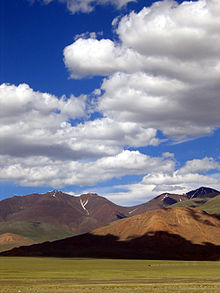This article needs to be updated. (April 2010) |

Agriculture in Mongolia constitutes over 10% of Mongolia's annual gross domestic product and employs one-third of the labor force.[1] However, the high altitude, extreme fluctuation in temperature, long winters, and low precipitation provides limited potential for agricultural development. The growing season is only 95 – 110 days.[2] Because of Mongolia's harsh climate, it is unsuited to most cultivation.
The agriculture sector therefore remains heavily focused on nomadic animal husbandry with 75% of the land allocated to pasture, and cropping only employing 3% of the population. About 35% of all households in Mongolia lived from breeding livestock.[3][4] Most herders in Mongolia follow a pattern of nomadic or semi-nomadic pastoralism.
Crops produced in Mongolia include wheat, barley, and potatoes. Animals raised commercially in Mongolia include sheep, goats, cattle, horses, camels, and pigs. They are raised primarily for their meat, although goats are valued for their hair which can be used to produce cashmere. Livestock breeds are increasingly challenged by land degradation and climate change. Populations suffer from more frequent and intense extreme weather events, especially brutal winter seasons called zuds that destroy forage and can decrease temperatures to around -50°C.[5] While zuds used to occur about once every ten years, there have now been six in the past decade, with over six million animals (9% of total livestock) killed by these conditions in the winter of 2024.[6]
- ^ Enkhbold, Enerelt. "The foreseeable future of Mongolia's agriculture". blogs.adb.org.
- ^ Werner Elstner: Mongolei, p. 18. Berlin 1993
- ^ "Statistical Yearbook 2002" (PDF). National Statistical Office. pp. 43, 151. Archived from the original (PDF) on March 25, 2009. Retrieved 2013-06-28.
- ^ "Bringing Herders Closer to Markets and Livestock Services". World Bank Group. World Bank. Retrieved 3 July 2024.
- ^ "Mongolia's livestock breeds, a precious part of global biological diversity". Food and Agriculture Organization of the United Nations. FAO. Retrieved 3 July 2024.
- ^ "Dzud emergency in Mongolia moves to risk of floods and environmental contamination". World Health Organization. WHO. Retrieved 3 July 2024.